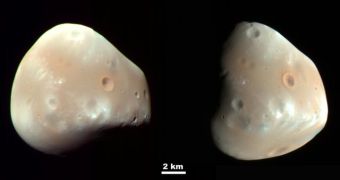Not many people know that the Red Planet, which has been intensely-scrutinized over the past few years with several rovers and orbiters, also has two very small moons, Deimos and Phobos. Discovered in 1877 by Asaph Hall, the two celestial bodies orbiting Mars are thought to be captured asteroids that can no longer escape the planet's gravitational pull. Just recently, the HiRISE instrument aboard the Mars Reconnaissance Orbiter (MRO) has captured a new series of pictures of Deimos and the surface of Mars itself, and the team coordinating the mission has made them available for public view on Monday.
The High Resolution Imaging Science Experiment (HiRISE) camera aboard the MRO is powerful enough to scout the ground below it to great detail, and has supplied numerous important data over the years to missions such as the Phoenix lander. On February 21st, 2009, the device took 2 new pictures of Deimos, as well as over 600 of Mars itself. And while most of the important features of the Red Planet are already known, no one could have said the same thing about the smallest of its moons.
Deimos is a small, reddish and dark object, which is covered with a layer of fragmental rock, or regolith. The only points where this omni-present blanket of rocks is interrupted is in recent meteor craters that have apparently struck the celestial body not too long ago. According to the team at NASA, this moon closely resembles Mars' other one, Phobos, which is built exactly in the same manner, and has very similar outer features to those of Deimos.
HiRISE has used several filters for the new picture, including near-infrared, the red, and the blue-green wavelengths, which have allowed analysts to also view an enhanced-color image of the natural satellite. These modified photos have made it possible for scientists studying them to notice small variations of color on the surface – the compact layer of regolith tends to be a bit more reddish than the rocks near fresh impact craters. The moon is roughly 12 kilometers (7.5 miles) in diameter, and it spins around Mars in about 1 day, 6 hours and 17.9 minutes.

 14 DAY TRIAL //
14 DAY TRIAL //